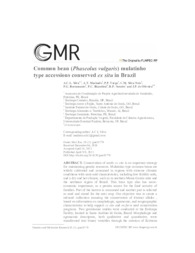Common bean (Phaseolus vulgaris) mulatinho type accessions conserved ex situ in Brazil.
Common bean (Phaseolus vulgaris) mulatinho type accessions conserved ex situ in Brazil.
Autoria: SILVA, A. C. L.; MACHADO, A. T.; TORGA, P. P.; SILVA NETO, C. M.; BUSTAMANTE, P. G.; BIANCHINI, P. C.; SORATTO, R. P.; OLIVEIRA, J. P. de
Resumo: Conservation of seeds ex situ is an important strategy for maintaining genetic resources. Mulatinho type common beans are widely cultivated and consumed in regions with extreme climatic conditions with semi-arid characteristics, including low fertility soils, and a dry and hot climate, such as in northern Minas Gerais state and the northeast region of Brazil. This bean type also has socio-economic importance, as a protein source for the food security of families. Part of the harvest is consumed and another part is selected as seed and stored for the next crop. Our objective was to create a reduced collection ensuring the conservation of distinct alleles , based on information on morphologic, agronomic, and ecogeographic characteristics to help support ex situ and on farm seed conservation programs. Two greenhouse studies were conducted at the Embrapa facility, located in Santo Antônio de Goiás, Brazil. Morphologic and agronomic descriptors, both qualitative and quantitative, were transformed into binary variables through the creation of fictitious variables. Descriptors were used to estimate the coefficient of similarity between two accessions and obtain the dissimilarity distance between the semi-partial correlation squared values. Experiment I was comprised of genetic material from 745 accessions of common beans and was planted in pots with three plants for each accession. In Experiment II, 240 accessions were selected from Experiment I, using four pots with three plants for each accession. The phenotypic data in this reduced group showed increased phenotypic dissimilarity, contributing information for research in plant breeding and for farmers who may need seeds. The mulatinho type common beans types can be reduced to 96 accessions, maintaining the conservation of distinct alleles, with a significantly higher mean number of pods and seeds, and of plant mass, compared to the initial collection of 745 accessions.
Ano de publicação: 2021
Tipo de publicação: Artigo de periódico
Unidade: Embrapa Semiárido
Palavras-chave: Conservação, Cowpeas, Feijão Mulatinho, Melhoramento Genético Vegetal, Phaseolus Vulgaris, Variabilidade genética
Observações
1 - Por padrão são exibidas publicações dos últimos 20 anos. Para encontrar publicações mais antigas, configure o filtro ano de publicação, colocando o ano a partir do qual você deseja encontrar publicações. O filtro está na coluna da esquerda na busca acima.
2 - Para ler algumas publicações da Embrapa (apenas as que estão em formato ePub), é necessário ter, no celular ou computador, um desses softwares gratuitos. Sistemas Android: Google Play Livros; IOS: iBooks; Windows e Linux: software Calibre.
Acesse outras publicações
Acesse a Base de Dados da Pesquisa Agropecuária (BDPA) para consultar o acervo completo das bibliotecas da Embrapa.

